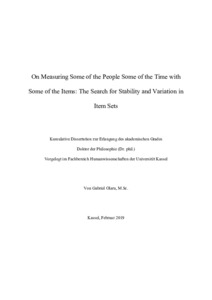| dc.date.accessioned | 2019-07-25T06:04:46Z | |
| dc.date.available | 2019-07-25T06:04:46Z | |
| dc.date.issued | 2019-02 | |
| dc.identifier | doi:10.17170/kobra-20190718606 | |
| dc.identifier.uri | http://hdl.handle.net/123456789/11279 | |
| dc.language.iso | eng | |
| dc.rights | Urheberrechtlich geschützt | |
| dc.rights.uri | https://rightsstatements.org/page/InC/1.0/ | |
| dc.subject.ddc | 150 | |
| dc.title | On Measuring Some of the People Some of the Time with Some of the Items: The Search for Stability and Variation in Item Sets | eng |
| dc.type | Dissertation | |
| dcterms.abstract | Psychological assessment is shaped by the items used and the persons assessed. Both items and persons typically represent a random or representative sample of a much larger item and person pool. However, most of the focus on psychological measurement rests on the person sampling side. Item sampling from larger item pools is still a black box. In this dissertation, I present the advantages of new state-of-the-art item and person sampling procedures in the context of personality development research (manuscript 1). Measurement in personality development faces many psychometric problems. First, the theoretically assumed measurement models do not fit the data when tested with confirmatory factor analysis. Second, measurement invariance across age, which is necessary for a meaningful interpretation of age-associated personality differences, is rarely accomplished. And third, the continuous moderator variable age is often artificially categorized. I show how Ant Colony Optimization can be used to select indicators that provide adequate model fit and measurement invariance across age (manuscript 2). I also apply a combination of the item sampling approach Genetic Algorithm and the person sampling approach Local Structural Equation Modeling to identify the items that provide the most prototypical measurement of personality within restricted age samples (manuscript 3). These manuscripts address two sides of the measurement invariance problem (i.e., the DIF paradox): If normative age-associated differences should be studied, measurement invariant indicators across age need to be selected. If the measurement within restricted age ranges should be optimized, indicators that maximize model fit and measurement variance across age need to be sampled. The novel item sampling procedures can be applied in any assessment context to optimize psychometric requirements (e.g., model fit, reliability, difficulty). The person sampling method Local Structural Equation Modeling can also be applied to any measurement to study the robustness across continuous moderator variables (e.g., cognitive abilities, SES). In the epilogue, I discuss implications for personality measurement and provide an outlook on future research. | eng |
| dcterms.abstract | Psychologische Messungen sind geprägt von den verwendeten Items und Personen. Beide stellen in der Regel eine zufällige oder repräsentative Stichprobe einer viel größeren Item- oder Personenpopulation dar. In der psychologischen Forschung konzentriert man sich jedoch oft nur auf die Personenziehung. Der Einfluss und die Vorteile von Itemsampling werden oft nicht beachtet. In dieser Dissertation stelle ich neue Item- und Personensamplingverfahren für die Persönlichkeitsentwicklungsforschung vor (Manuskript 1). Messungen in der Forschung zur Persönlichkeitsentwicklung sind aus mehreren Gründen problematisch: 1) Konfirmatorische Faktorenanalysen lehnen die theoretisch fundierten Messmodelle ab. 2) Messinvarianz übers Alter, die für eine sinnvolle Interpretation altersbedingter Persönlichkeitsunterschiede notwendig ist, wird selten erreicht. 3) Die kontinuierliche Variable Alter wird oft künstlich kategorisiert. In dieser Dissertation verwende ich Ant Colony Optimization, um Persönlichkeitsitems auszuwählen, die eine adäquate Modellanpassung und Messinvarianz über das Alter hinweg bieten (Manuskript 2). Ich wende eine Kombination aus dem Itemziehungsverfahren Genetischer Algorithmus und der Personengewichtungsmethode Lokale Strukturgleichungsmodellierung an, um Items zu identifizieren, die Alter-prototypische Messungen der ermöglichen (Manuskript 3). Beide Manuskripte behandeln zwei Aspekte des Messinvarianzproblems: Wenn Mittelwertsverläufe untersucht werden sollen, müssen messinvariante Items über das Alter hinweg ausgewählt werden. Wenn die Messung in eingeschränkten Altersbereichen optimiert werden soll, müssen Items zur Maximierung der Modellanpassung und Messvarianz übers Alter gezogen werden. Diese neuartigen Item- und Personensamplingverfahren können auf jede Art von psychologischer Messung angewendet werden um psychometrische Eigenschaften der Messung zu optimieren (z. B., Modelfit, Reliabilität, Schwierigkeit) und um die Robustheit über kontinuierliche Moderatoren zu untersuchen (z. B. Intelligenz, sozi-ökonomischer Status). Im Epilog diskutiere ich Implikationen für die Persönlichkeitsmessung und gebe einen Ausblick auf zukünftige Forschungsvorhaben. | ger |
| dcterms.accessRights | open access | |
| dcterms.creator | Olaru, Gabriel | |
| dcterms.dateAccepted | 2019-07-17 | |
| dcterms.extent | I-28, II-58, III-33, IV-47, V-23 Seiten | |
| dc.contributor.corporatename | Kassel, Universität Kassel, Fachbereich Humanwissenschaften | |
| dc.contributor.referee | Schroeders, Ulrich (Prof. Dr.) | |
| dc.contributor.referee | Wilhelm, Oliver (Prof. Dr.) | |
| dc.relation.doi | doi:10.1002/per.2185 | |
| dc.relation.doi | doi:10.1002/per.2195 | |
| dc.relation.doi | doi:10.1111/jopy.12373 | |
| dc.subject.swd | Persönlichkeitsentwicklung | ger |
| dc.subject.swd | Psychologie | ger |
| dc.subject.swd | Messung | ger |
| dc.subject.swd | Testtheorie | ger |
| dc.type.version | publishedVersion | |

